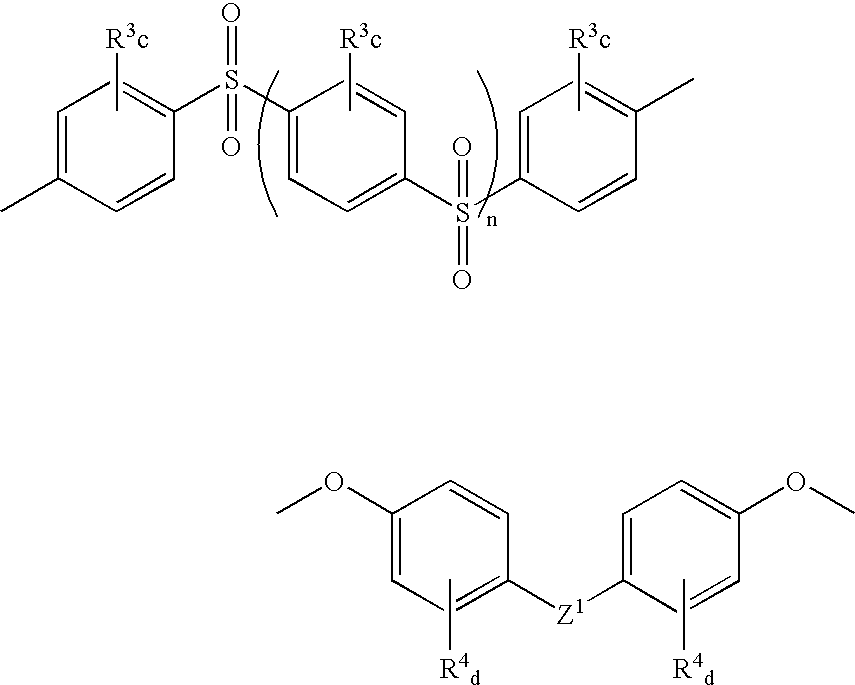Sulfonated polyaryletherketone-polyethersulfone block copolymers
- Summary
- Abstract
- Description
- Claims
- Application Information
AI Technical Summary
Benefits of technology
Problems solved by technology
Method used
Image
Examples
example 1
Synthesis of 3,3′-Disulfonated-4,4′-Difluorobenzophenone
[0051] Difluorobenzophenone (100 g, 0.458 mol) was transferred into a 1 L round bottom flask and 250 mL fuming sulfuric acid (30% SO3) was added. The mixture was stirred under nitrogen at 110° C. for 7 hours. The mixture was cooled to room temperature and poured into 1.5 L of ice water. The insoluble material was filtered off. NaCl was added to the solution to salt out the product. The white pasty solid was isolated on a large Buchner funnel, redissolved in a minimum of deionized water, and neutralized to pH 7 using 10N NaOH. The product was again salted out with NaCl. The white pasty solid was recrystallized from 3:1 isopropanol / water (note: some grayish water insoluble material should be filtered off before recrystallizing.) Isolated yield: 71 g (37%). 1H NMR (DMSO-d6): δ 7.34 (t, 2H), 7.72 (m, 2H), 8.07 (dd, 2H).
example 2
Synthesis of Random Sulfonated Polyetheretherketone-Polyethersulfone
[0052] 4,4′-Biphenol (1 g, 5.37 mmol) and K2CO3 (1.113 g, 8.06 mmol) were transferred into a three-neck flask connected to a Dean-Stark trap / condenser, nitrogen inlet, and mechanical stirrer. Anhydrous DMSO (7 mL) and toluene (2 mL) were added. The mixture was stirred at 145° C. for 2.5 hours. Sulfonated difluorobenzophenone (1.134 g, 2.69 mmol) and 4,4′-difluorodiphenylsulfone (0.683 g, 2.69 mmol) were added to the reaction, and the mixture was stirred at 145° C. for 1 hour, after which the mixture became very viscous. DMSO (9 mL) was added to dilute, and the mixture was stirred for another 30 minutes until it became more viscous again. The mixture was further diluted with DMSO (15 mL) and poured into stirring isopropanol. The polymer was isolated, dried under vacuum briefly, and washed / soaked in deionized water until the filtrate pH was neutral. The polymer was dried under vacuum at 100° C.
example 3
Synthesis of Blocky Sulfonated Polyetheretherketone-Polyethersulfone
[0053] The length of the SPEEK block was adjusted by the stoichiometry of sulfonated difluorobenzophenone and 4,4′-biphenol. The degree of sulfonation was adjusted by the ratio of SPEEK:PES block length. Sulfonated difluorobenzophenone (1.3 g, 3.08 mmol), 4,4′-biphenol (0.688 g, 3.69 mmol), and K2CO3 (1.404 g, 10.2 mmol) were transferred into a three-neck flask connected to a Dean-Stark trap / condenser, nitrogen inlet, and mechanical stirrer. DMSO (4.5 mL) and toluene (2 mL) were added. The mixture was stirred at 145° C. for 1 hour, after which the mixture became pasty. 4,4′-Difluorodiphenylsulfone (0.939 g, 3.69 mmol), 4,4′-biphenol (0.573 g, 3.08 mmol), and DMSO (3.5 mL) were added. The orange SPEEK oligomer paste was scraped off the sides of the flask into the solution to facilitate the reaction. (This situation can be avoided by using a more dilute reaction mixture.) The mixture was stirred vigorously without he...
PUM
| Property | Measurement | Unit |
|---|---|---|
| Fraction | aaaaa | aaaaa |
| Fraction | aaaaa | aaaaa |
| Fraction | aaaaa | aaaaa |
Abstract
Description
Claims
Application Information
 Login to View More
Login to View More - R&D
- Intellectual Property
- Life Sciences
- Materials
- Tech Scout
- Unparalleled Data Quality
- Higher Quality Content
- 60% Fewer Hallucinations
Browse by: Latest US Patents, China's latest patents, Technical Efficacy Thesaurus, Application Domain, Technology Topic, Popular Technical Reports.
© 2025 PatSnap. All rights reserved.Legal|Privacy policy|Modern Slavery Act Transparency Statement|Sitemap|About US| Contact US: help@patsnap.com



